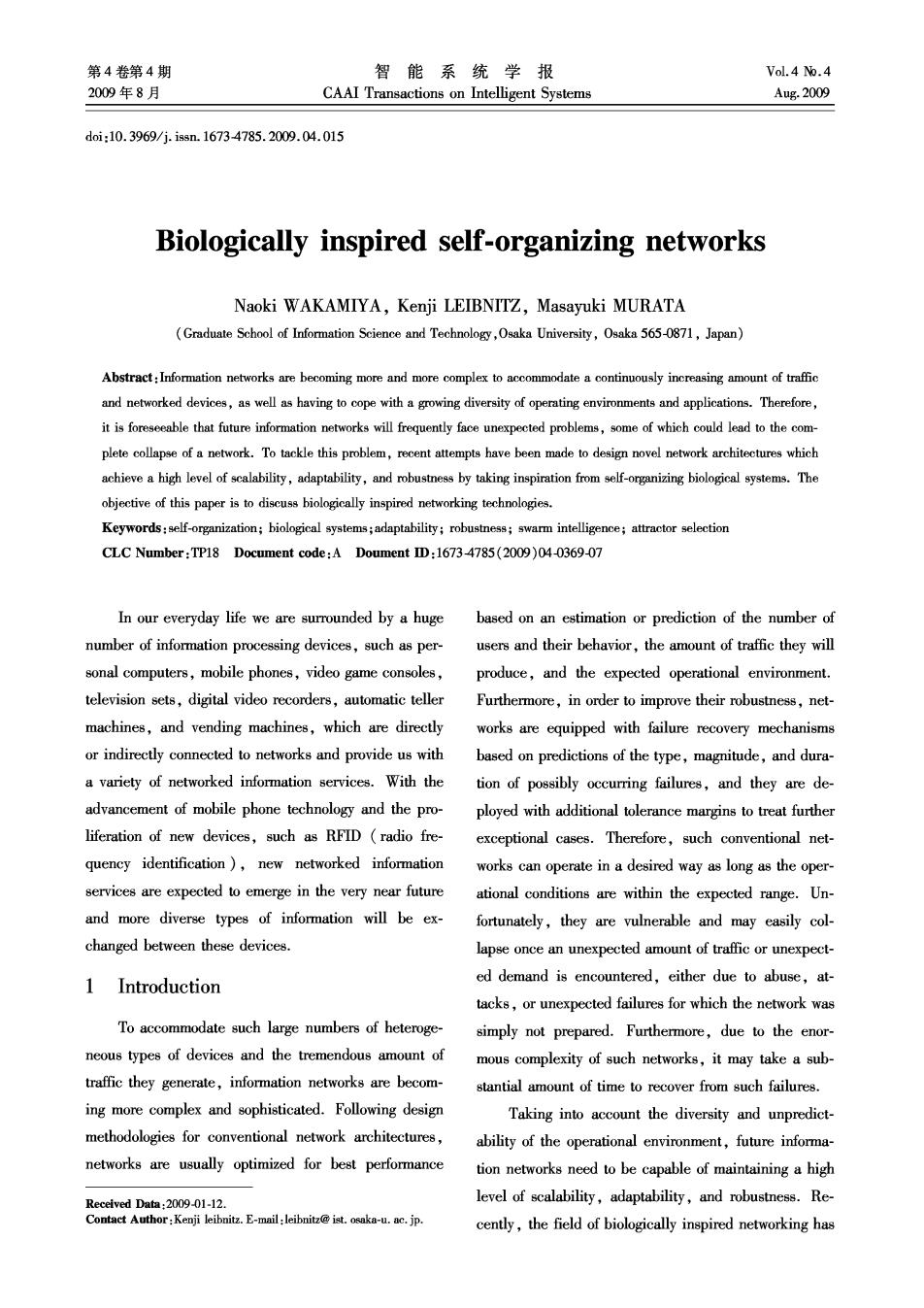正在加载图片...

第4卷第4期 智能系统学报 Vol.4 No.4 2009年8月 CAAI Transactions on Intelligent Systems Ag.2009 doi:10.3969/j.issn.16734785.2009.04.015 Biologically inspired self-organizing networks Naoki WAKAMIYA,Kenji LEIBNITZ,Masayuki MURATA Graduate School of Information Science and Technology,Osaka University,Osaka 565-0871,Japan) Abstract:Information networks are becoming more and more complex to accommodate a continuously increasing amount of traffic and networked devices,as well as having to cope with a growing diversity of operating environments and applications.Therefore, it is foreseeable that future information networks will frequently face unexpected problems,some of which could lead to the com- plete collapse of a network.To tackle this problem,recent attempts have been made to design novel network architectures which achieve a high level of scalability,adaptability,and robustness by taking inspiration from self-organizing biological systems.The objective of this paper is to discuss biologically inspired networking technologies. Keywords:self-organization;biological systems;adaptability;robustness;swarm intelligence;attractor selection CLC Number:TP18 Document code:A Doument ID:1673-4785(2009)04-0369-07 In our everyday life we are surrounded by a huge based on an estimation or prediction of the number of number of information processing devices,such as per- users and their behavior,the amount of traffic they will sonal computers,mobile phones,video game consoles, produce,and the expected operational environment. television sets,digital video recorders,automatic teller Furthermore,in order to improve their robustness,net- machines,and vending machines,which are directly works are equipped with failure recovery mechanisms or indirectly connected to networks and provide us with based on predictions of the type,magnitude,and dura- a variety of networked information services.With the tion of possibly occurring failures,and they are de- advancement of mobile phone technology and the pro- ployed with additional tolerance margins to treat further liferation of new devices,such as RFID (radio fre- exceptional cases.Therefore,such conventional net- quency identification )new networked information works can operate in a desired way as long as the oper- services are expected to emerge in the very near future ational conditions are within the expected range.Un- and more diverse types of information will be ex- fortunately,they are vulnerable and may easily col- changed between these devices. lapse once an unexpected amount of traffic or unexpect- 1 Introduction ed demand is encountered,either due to abuse,at- tacks,or unexpected failures for which the network was To accommodate such large numbers of heteroge- simply not prepared.Furthermore,due to the enor- neous types of devices and the tremendous amount of mous complexity of such networks,it may take a sub- traffic they generate,information networks are becom- stantial amount of time to recover from such failures. ing more complex and sophisticated.Following design Taking into account the diversity and unpredict- methodologies for conventional network architectures, ability of the operational environment,future informa- networks are usually optimized for best performance tion networks need to be capable of maintaining a high Received Data:2009-01-12. level of scalability,adaptability,and robustness.Re- Contact Author:Kenji leibnitz.E-mail:leibnitz@ist.osaka-u.ac.jp. cently,the field of biologically inspired networking has